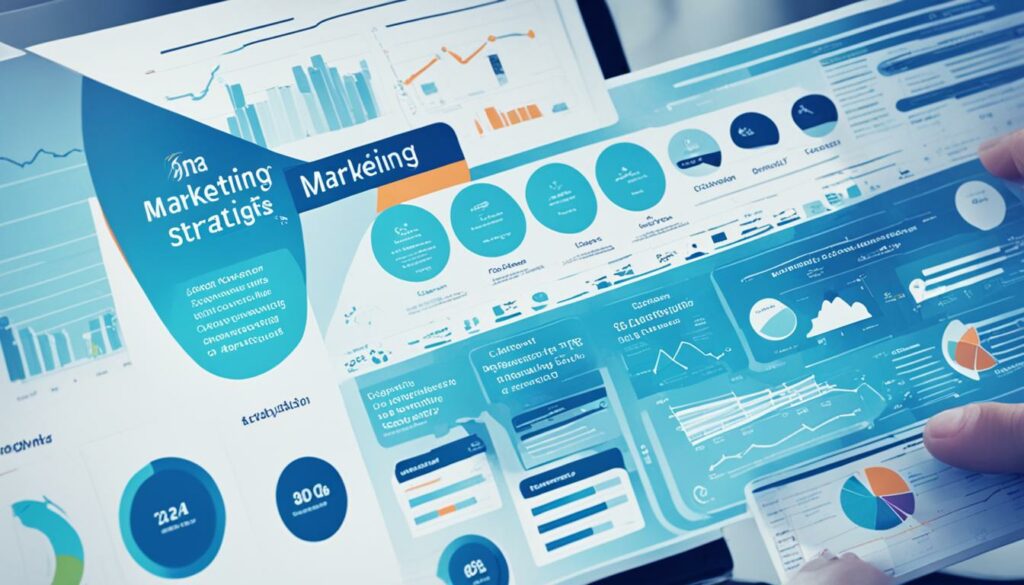Menu

Did you know defining ideal client personas raised a bakery’s sales by 15%? Or that tailoring an editorial plan increased website traffic by 30% for a digital marketing agency? These results highlight the power of strategic market analysis. It’s essential for entrepreneurs to grasp the importance of market trends and customer behaviours for success.
Strategic market analysis is the foundation of smart decision-making. It helps companies refine strategies, reduce risks, and spot new chances. Understanding your customers’ preferences and behaviours is key. This knowledge lets you adjust your marketing tactics to shine in a busy market.
Strategic market analysis is essential for any business looking to succeed today. It means carefully looking at how the market works, what the competition does, and how customers behave. This helps make smart choices that lead to ongoing success.
At the heart of it, strategic market analysis is about getting and reviewing information. This info helps businesses plan ahead. It looks at trends, what customers like, and what other companies are up to.
Using analytics is key for doing well in the future. A lot of top businesses, about 92%, see the value in this. A study from Salesforce in 2015 found that even more companies think analytics is becoming more important.
Market analysis is not just about the past, it’s about foreseeing what’s next. This is critical for making choices that help the business do better. Leaders play a big part in using this information to set strong company goals.
Tools like SWOT and PESTLE analysis help do a deep dive into a business’s strategy. They show what the business does well, where it can improve, and what’s happening in the wider world. This helps in planning for the future.
For fast-changing industries, regular market analysis is a must. A careful, step-by-step approach can help a company focus, set clear targets, and use its resources wisely.
Knowing who you’re talking to is crucial in marketing. It’s about crafting messages that hit the mark. This not only improves your success but also leads to uncovering some real gems. We’re going to show you how to look deep into your audience’s world. This means getting to grips with who they are and what they like.
Demographics are the basics, like age and where people live. They’re also about how much money they make, their education, and jobs. For example, knowing their age can show you what products will interest them. And looking at income tells you how much they can spend. This information is key in your research. It makes sure your marketing plans really connect with your audience.
| Demographic Factor | Importance |
|---|---|
| Age | Identifies the suitable product age range |
| Location | Determines regional market demand |
| Income | Assesses purchasing power |
| Education Level | Indicates product complexity suitability |
Psychographics go further. They look at what your audience loves to do and what they really care about. Tools like Google Analytics can help with this. They let you build detailed pictures of your audience. This helps make your marketing personal. It speaks directly to what matters most to your audience.

By digging into both demographics and psychographics, you really get to know your audience. This knowledge is power. It lets you create content that people truly engage with. And, at the end of the day, that’s what leads to more sales. But, let’s remember, getting to know your audience well takes time and effort. Yet, it is a vital part of any solid marketing strategy.
Using the right market analysis tools is key. They help businesses stay ahead and make smart choices. Tools like Google Trends, Semrush, Ahrefs, and Quantcast offer deep insights. These can guide your plans and improve how you work.
Google Trends shows what people are searching for online. It highlights where and when people are most interested. This helps businesses focus their marketing to catch the eyes of their audience.
It’s great for spotting trends and sudden jumps in interest too. Companies can then adjust their strategies quickly. This keeps them ahead of the game.
They help tweak SEO and find new content opportunities. Both are great for boosting your marketing efforts overall.
Quantcast dives into website traffic to understand who’s visiting your site. It unlocks info on your audience’s age, interests, and more. With this data, you can make marketing that really speaks to your customers.
Your ads or content become more tailor-made. This drives better results and more business.
Putting these tools together can really amp up your data game. They help refine your approach and make your strategies more powerful.
Good market analysis relies on strong market intelligence services. They help you understand what consumers do, what rivals are up to, and new market trends. By gathering and making sense of data, these services offer real, useable insights.
Market intelligence starts by collecting data. This involves surveys, interviews, and watching social media. Using these methods, organisations build a detailed picture of their market. Important numbers like how much it costs to get a new customer and how people feel about your brand (NPS) come from this.

These methods also shed light on how valuable a customer is over their life with your business. They help you see how you’re doing against competitors online and understand keyword trends. This all helps adjust your online strategies.
Analysing market data turns it into useful plans. With this info, companies understand more about what the market and consumers really need. They look at things like brand awareness and sales data to see what’s working best.
This helps companies make smart choices about their products and prices. They can spot new chances and plan better to stand out from competitors. Using the PESO model, they figure out the best ways to spend their resources for the biggest impact.
| Metric | Description |
|---|---|
| Customer Acquisition Cost (CAC) | Measure how much is spent to acquire a new customer |
| Customer Lifetime Value (CLTV) | Estimate the total value of a customer to the business over the entire relationship period |
| Market Share | Measure the portion of the market owned compared to competitors |
| Top-of-Mind Scores | Evaluate brand recognition across the target market |
| Net Promoter Score (NPS) | Assess customer loyalty and the likelihood of recommending the business |
| Sentiment Analysis | Determine whether customers have a positive or negative view of the brand |
| Sales and Revenue Data | Track which products are positively affecting the bottom line |
| Visits and Keyword Rank | Analyze digital marketing and SEO metrics to compare website performance with competitors |
With advanced market intelligence, companies can be ready for changes in the market. This helps them react quickly and smartly. The aim is to always be ahead, reducing risks, and finding new chances in the market.
Conducting a competitive market analysis is key for staying ahead in business. It involves looking at what your rivals do. This means studying how they set prices, use social media, and more. It helps a company see clearly where it stands. Also, it shows how to spot areas to grow.
Competitor strategies vary. Some may fight directly; others may do so indirectly. Knowing your rivals’ strategy types, such as those that follow traditional ways or those who break the mould, is crucial.
This analysis looks at things like prices and ads. It lets companies see what works well and where others might fail. This knowledge is powerful for staying strong in the market.
In the tech world, knowing what’s new and what’s ending is vital. It keeps tech companies moving fast. They use this info to stay ahead.
Spotting what’s missing in the market is critical. It means finding out what customers want but can’t get. This is where new ideas can shine.
This step makes a product or service more valuable. Plus, it helps set goals for the future. By fixing what bugs customers, a business can keep them close.
Doing this kind of study often makes a company smart. It can act fast in a changing market. Quick tech changes or tough rivals might mean checking in more. But, it’s all about keeping that lead or finding new ways to go.
| Competitor Type | Examples | Focus |
|---|---|---|
| Direct | Asana, Basecamp | Similar products or services |
| Indirect | Slack, Notion | Alternative solutions |
| Legacy | Microsoft Project, Jira | Traditional market players |
| Disruptor | ClickUp, Airtable | Innovative new entrants |
This table helps make sense of your competition. It shows who they are and what space they fill. With this clear view, a company can make smart moves. They can focus on what sets them apart from the rest.
Understanding market dynamics through market trends analysis is crucial. It helps in keeping business growth steady. Markets change quickly and spotting new trends early is key. Being proactive in adapting to these shifts is important.

Discovering emerging trends uses a mix of methods. By using analytics, businesses can find areas for growth. For instance, 92% of top performers see analytics as essential for success. It’s about looking at both numbers, like market size, and the feelings and motives of consumers. Understanding these insights helps make accurate predictions and adjust strategies.
| Market Analysis Components | Benefits |
|---|---|
| Quantitative Data | Understand market size, revenue forecasts, and pricing structures. |
| Qualitative Data | Gain insights into consumer values, preferences, and unmet needs. |
Adapting to market changes is vital for staying competitive. With 65% of companies trusting more in analytics, adjusting to trends is essential. It means using past consumer data to predict future demands accurately. This leads to a stronger and more flexible business approach.
By blending market trends analysis with a bigger business strategy, firms find low-risk opportunities. They also improve their position in the market and how they work. This approach makes businesses more stable against market ups and downs. It helps in making decisions with more confidence.
Using market analysis software can make finding and sorting lots of data easier. It’s now key for many companies. 92% of top businesses see it as key to their future. The right software can turn piles of data into useful ideas.
When choosing market analysis software, look for features that match what your business needs:
Here are some top software options known for their great features and performance:
| Software | Main Features | Strengths | Suitability |
|---|---|---|---|
| Tableau | Data visualisation, real-time analytics, integration with multiple sources | User-friendly interface, robust visualisation capabilities | Businesses of all sizes requiring strong visual data representation |
| IBM Watson Analytics | AI-driven insights, natural language processing, predictive analytics | Advanced analytics powered by AI, comprehensive data integration | Large enterprises needing in-depth predictive analysis |
| Microsoft Power BI | Data sharing, real-time dashboards, extensive reporting | Integration with Microsoft products, extensive customisation options | Organisations seeking integration with Microsoft ecosystem |
| SAS Business Intelligence | Data mining, predictive modelling, dashboard creation | Strong statistical analysis capabilities, reliable performance | Industries requiring heavy data mining and complex analytics |
A strong marketing strategy is key for today’s businesses to do well. It combines both traditional and online methods. This mix helps companies get the best out of both worlds.

Bringing together old and new marketing helps companies connect more with their customers. Things like ads in newspapers, direct mail, and holding events let people touch and feel the brand. Digital methods, such as being active on social media or sending emails, offer quick and flexible ways to talk to the audience.
This mix lets businesses be adaptable. They can change with what their audience wants and make sure more people know about them.
Businesses need to keep checking if their marketing works. They do this by looking at specific numbers, like how much it costs to get a new customer (CAC) or the return they get from their spending (ROI). These numbers tell them how well their initiatives are going.
Keeping current customers happy is equally important. The goal is to lose fewer customers each year and sell more upgrades. This keeps customers coming back and appreciating the value the business brings.
A good marketing plan is always evolving. Through regular checks, looking at data, and making changes where needed, companies can grow. This approach helps meet the company’s bigger goals and stay ahead in the marketplace.
Knowing how to wisely spend the marketing budget is key. In 2023, marketing budgets compared to total revenue are falling. Companies are trying to be more careful with their spending. A survey found 75% of Chief Marketing Officers are feeling the pressure to get more results with less money.
The consumer product industry spends about 10.9% of its revenue on marketing. It’s smart to use both digital and traditional methods. Let’s see how budgets are normally split:
| Category | Percentage of Budget |
|---|---|
| Digital Marketing | 40-50% |
| Traditional Marketing | 20-30% |
| Events and Sponsorships | 10-20% |
| Research and Analytics | 5-10% |
Using top-notch marketing analytics can lead to big wins. It can bring a return on investment (ROI) of 140% to 400% over three years. Tools like Improvado are a big help, depending on how advanced your analytics are.
Following the 70/20/10 rule can make your marketing money go further. This rule says you should spend:
This mix spreads out the risk and keeps your marketing sharp. By always checking what’s working best, you can put money where it’ll do the most good. That’s how you get the most from your marketing budget.
Data-driven marketing isn’t just a trend today; it’s a must-have. By using big data, companies can understand customer information better. This lets them make their marketing more personal and effective, increasing sales and keeping customers happy.

With big data, businesses dive into vast information like customer details, what they like, how they act, and what they’ve bought. Studies show that companies using big data get more return on investment, five to eight times more. This helps them better focus their marketing to speak directly to different customer groups, for example, Millennials.
Using big data helps companies stand out in a busy market. A lot, 64%, of marketing leaders agree it gives them an edge. When businesses tailor their messages to each customer, using details like what they’ve bought before or what they’ve looked at online, customers feel more understood. This boosts loyalty and interest. Also, testing different versions of campaigns helps find the best one, saving time and money.
Adopting data-driven marketing faces some hurdles, too. Challenges include dealing with bad data, keeping data apart in different places, and ensuring it’s all safe. By checking and cleaning up databases, companies can target customers more accurately. Plus, with the help of artificial intelligence and machine learning, they can predict what customers want. This allows for instant, personalized marketing, creating immediate connections.
To stay ahead in the digital world, crafting great marketing campaigns is key. These campaigns mix social media and SEO to make sure companies connect with their audience. They also aim to make a strong impression on people.
Engaging with people on social media is vital for successful campaigns. Many consumers use Facebook, Instagram, and Twitter. So, using the right strategies can boost how well a brand is known and trusted.
Nearly 83 percent of businesses don’t have a clear digital marketing plan. This means there’s a big chance to do something different. One effective approach is to target different customer groups with tailor-made strategies.
This lets businesses connect with people better. They can then track how well they’re doing by looking at metrics like click-through rates. This info helps tweak strategies for better results.
SEO is still a major way to get more visitors to a website. It helps your content show up in online searches, helping customers find you. 20 percent of marketers have changed their strategies, showing how flexible we need to be.
Understanding how customers look for information is crucial. This lets businesses create content that grabs attention at every step. Using tools like data analytics helps fine-tune SEO efforts for best results.
Digital marketing requires a clear, smart plan, paying close attention to details, and knowing your audience well. By focusing on social media and SEO, businesses can run successful, long-lasting campaigns.
Content marketing is vital in strategic market analysis. It helps businesses create strong bonds with their clients. This is achieved by using what they know about what people like and do. Then, they make content that really connects with them.

Building strong content sets apart the best marketing plans. The Content Marketing Institute says it can boost sales, save money, and make customers more loyal. When businesses talk about what their audience cares about, they draw them in. This encourages them to buy what’s offered.
A good content plan includes knowing who your audience is, what’s popular, and the best way to share your content. Smart companies make a content map to guide potential buyers. It ensures they see the right stuff at the right time, improving how they interact with the brand.
How you spread your content is crucial. 93 percent of businesses focus on getting their message to the right place. They pick their channels carefully to match where their audiences spend time.
You can share content on social media, through emails, or blogs on your website. Making your content easy to find on search engines is also important. It draws in new visitors. Putting some valuable content behind a form can help you get new leads. And, helpful content keeps customers happy, making them stick around longer.
By using content marketing well, companies can become well-known experts in their field. Today, in almost all marketing, content is king. It works together with other methods to meet big business goals.
Strategic market analysis is vital for any business aiming for success. It involves studying market trends, customer behaviour, and the actions of competitors closely. From my experience, mastering the art and science of strategic management is essential. It allows companies to update their plans efficiently.
Strategic analysis means looking at what makes other businesses thrive or fail. It involves a detailed look at key industry measures. For example, keeping track of the market regularly helps spot future trends and estimate profits. This method can lower risks and keep a business at the forefront. Throughout history, leaders like Ramese II and business icons like Sam Walton show how smart strategies make a big difference.
Combining thorough market reviews with smart tools for strategic management is crucial. It helps businesses understand their path and improve their plans. Using reputable data sources, such as the U.S. Bureau of Labor Statistics, aids in finding and knowing customers better. This knowledge allows businesses to offer exactly what their customers want, boosting sales and outshining rivals.
In conclusion, strategic market analysis is key to business victory. Whether learning from ancient leaders or using the latest tech tools, it’s about gaining insights for smart choices. This helps companies be agile against market changes, better their promotional activities, and achieve long-term success.
Strategic Market Analysis looks at market dynamics, competition, and customer actions. It helps businesses make smart strategies based on market insights. This approach checks and improves how a business stands in the market. It also spots new chances to grow.
It’s key to grasp what your customers want and how they act. Knowing this makes your decisions stronger and your risks lower. You can see where the market is going and where to focus your efforts.
Start by looking at basic details like age and interests. Then, check what they like and how they think. This mix gives you a good picture of who you’re aiming at. It makes your messages more personal and appealing.
There are many tools to help, such as Google Trends for where your customers are. Use tools like Semrush and Ahrefs to see what keywords are working for others. Quantcast tracks website visits to give you clues on what’s popular.
They help gather and understand lots of data about the market and customers. With this info, you can plan your products and prices better. It also guides your marketing efforts, making your place in the market stronger.
Start by studying what your rivals are doing online and elsewhere. Look into their social posts, ads, and prices. Compare this with what customers miss or want. This can lead to ways you can stand out and draw in new business.
Keeping an eye on market trends prepares your business for what’s coming. By spotting new trends early, you can adjust and stay ahead. This keeps you sharp and ready in the ever-changing business world.
Choose software that’s easy to use and shows data clearly. Real-time updates and the ability to link with other tools are also key. The right software should help you make strong decisions with solid information.
Mix traditional methods with the latest digital ones. Use data to see what’s working and what’s not. This helps you tweak your plans to get the best results. Making sure your message hits home with your audience is crucial.
Spend your budget where your audience is most active. Try several approaches to see what works best. This helps make sure you’re not wasting money on things that don’t bring results.
Big data helps tailor your marketing to fit your customers’ needs. By understanding what customers like, you can make marketing that’s more personal. This can win over more loyal customers.
Focus on being active on social media and easy to find online. By being social and search-friendly, you attract more people. This can turn one-time visitors into long-term customers.
Creating and sharing useful content can draw people to your brand. Good content makes you a trustworthy source in your field. It helps strengthen your standing and plan in the market.